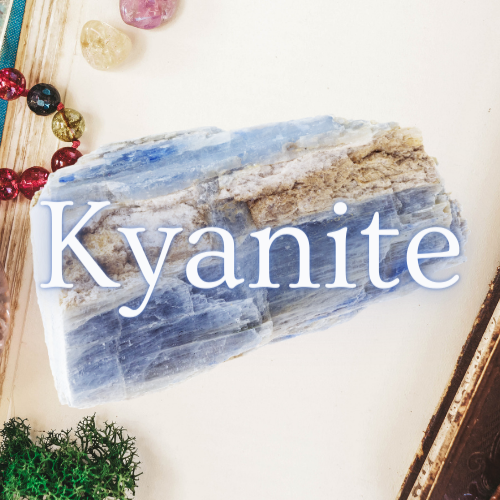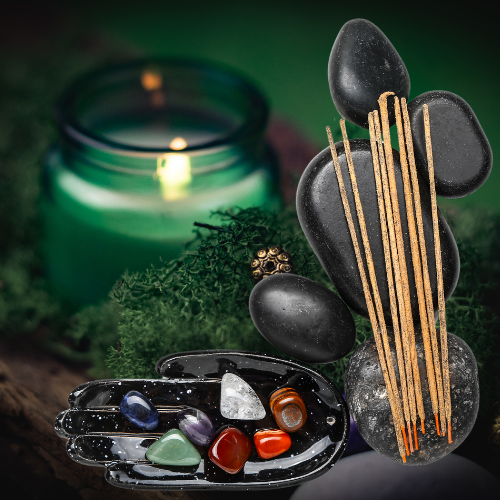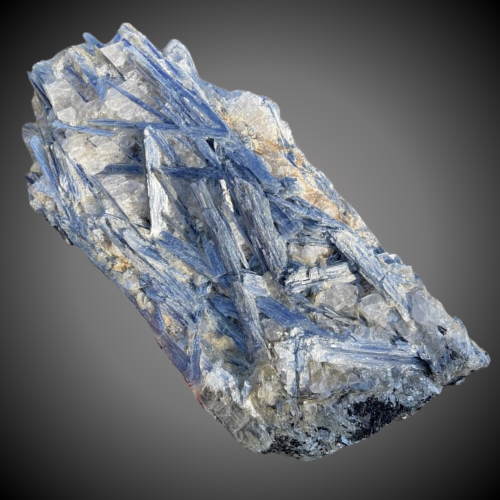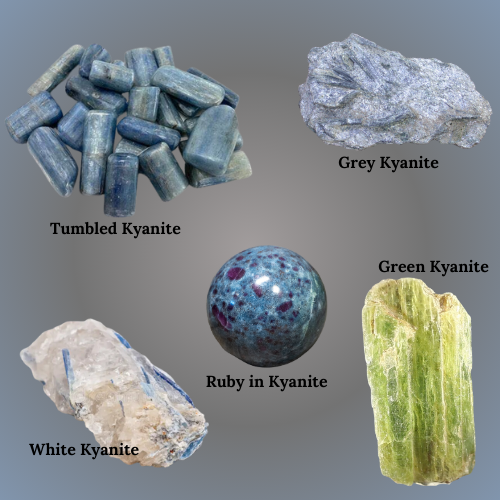Kyanite
Formation, Metaphysical Uses, and Historical Significance

Kyanite, with its mesmerizing hues and ethereal beauty, holds within it a fascinating tale of geological wonder and natural artistry. Formed over millions of years under the earth's surface, the creation of kyanite is a testament to the transformative power of heat, pressure, and time. In this enchanted crystal chronicle, we will discuss my favorite uses, geological formation, history, healing properties, metaphysical uses, and more.

Ways to use Kyanite
As kyanite crystals grow and evolve within the depths of the earth, they bear witness to the profound forces of transformation that shape our planet. Each crystal carries within it a record of geological history, capturing the passage of time and the dynamic processes that have sculpted the earth's surface over millennia. Let's explore how Kyanite is used in different practices, and how to best use this as an intention, metaphysical, or healing stone.
Metaphysical & Healing Properties:

Metaphysical Beliefs:
As a stone aligned with the throat chakra, kyanite is revered for its ability to promote clear communication, self-expression, and spiritual alignment. It is believed to open the pathways of communication between the mind and the heart, fostering harmony and balance within the soul.
Healing Properties:
This luminous crystal is known for its capacity to calm the nervous system, alleviate anxiety, and promote deep relaxation. By working with kyanite, individuals may experience a profound sense of inner peace, clarity, and emotional well-being, as they attune to the gentle rhythms of the universe.

Some of my favorite uses for Kyanite:
Writer's Block:
My favorite use for Kyanite is for writing. As a communicative stone, it goes hand in hand with written communication. I wear it as a bracelet on my right hand, because I am right handed, when using it for this purpose.
Enhancing Interspecies Communication:
Since Kyanite is mostly known to be a communication stone, I thought, what if it could act as a communication device for interspecies telepathy? When using Kyanite in this manner I carry a piece of tumbled Kyanite and rub it between my pointer finger and thumb to send messages, and hold it up to third eye, or forehead, to receive messages.
Creating a Fools Lock:
A Fool's Lock is (a phrase I am making up) a lock you place as a trick to detour people from using the real lock. A prank, if you will, to keep your protection in place. This is valuable to me as a practioner who shares their practice, as I do not want people to be able to break through my wards or any spells I share. I act on Kyanite's double Mohs hardness to tap into this enchantment, and use Kyanite chips in my ward or spells to enchant this energy.

Practical Uses:
In the modern world, Kyanite holds value among a diverse array of individuals, spanning spiritualists, crystal collectors, energy healers, jewelers, and even within industrial applications.
Kyanite plays a vital role in industrial sectors, particularly in the production of refractory and ceramic products. These include essential items such as porcelain plumbing fixtures and dishware, electrical insulators and abrasives.
One of the most fascinating transformations of Kyanite lies in its conversion into mullite fiber, a material with a myriad of uses. From the ignition of spark plugs to the containment of molten steel, mullite fiber derived from Kyanite finds its application in a diverse range of products and industries.

Chinese Stone Medicine:

Balancing Qi and Energy Flow:
In Chinese medicine, kyanite is thought to have a calming and balancing effect on the body's Qi (life force energy) and energetic meridians. It is believed to help regulate the flow of energy throughout the body, promoting harmony and balance within the energetic system.
Clearing Blockages and Stagnation:
Kyanite is thought to have the ability to clear energetic blockages and remove stagnation in the body's meridians. By clearing away obstacles to the flow of Qi, kyanite is believed to promote vitality, resilience, and overall well-being.
Supporting the Throat Chakra:
In Chinese medicine and energy healing practices, kyanite is associated with the throat chakra, which governs communication, self-expression, and truth. It is believed to help open and align the throat chakra, facilitating clear and authentic expression of thoughts and emotions.
Promoting Emotional Balance:
Kyanite is thought to have a soothing and calming effect on the emotions, making it beneficial for individuals experiencing stress, anxiety, or emotional turmoil. It is believed to help promote inner peace, tranquility, and emotional resilience in the face of challenges.
Enhancing Meditation and Spiritual Practices:
In Chinese medicine and spiritual traditions, kyanite is valued for its ability to deepen meditation practices and enhance spiritual awareness. It is believed to quiet the mind, promote inner stillness, and facilitate connection with higher realms of consciousness.

History and Lore
Throughout the annals of history, kyanite has been revered and cherished by cultures around the world for its mystical properties and transformative qualities. In ancient civilizations, it was often associated with the element of water and revered as a symbol of purity, truth, and spiritual enlightenment. In ancient Greece, kyanite was believed to bring tranquility and calmness. It was often used in jewelry and amulets to promote inner peace and balance. Princess Karam famously wore a necklace made of Kyanite believing it was Sapphire. Its name derives from the Greek word "kyanos," meaning "blue." Also, a derivative of cyan.

The Science of Kyanite
Geological Origins Kyanite is found worldwide within regions of high-grade metamorphism. It is commonly found in association with minerals such as mica, quartz, and garnet. Significant deposits exist in the United States (particularly North Carolina), Brazil, Nepal, India, Myanmar, and Australia.

Crystal Growth: The formation of kyanite begins deep within the earth's crust, where minerals undergo a process of recrystallization in response to the extreme conditions present. As temperatures and pressures rise, aluminum-rich minerals such as andalusite and sillimanite undergo metamorphic transformations, giving rise to the crystalline structure of kyanite.

Distinctive Characteristics: Kyanite is quite unique among gemstones due to its special crystal structure, which gives it exceptional hardness along two different axes. On the Mohs hardness scale, kyanite typically ranks between 4.5 and 7, depending on how you measure it. This means it's incredibly resistant to scratching and abrasion. The reason for this toughness lies in the way its crystals grow in blade-like or columnar shapes, with distinct lines and breaks that reflect how they formed. This combination of features makes kyanite both durable and strong, making it a popular choice for jewelry and other lapidary uses.

Inclusions and Color Variations: In addition to its striking blue hues, kyanite may also display shades of green, gray, or white, depending on variations in mineral composition and trace elements present during its formation. Inclusions of other minerals, such as quartz or mica, may impart additional complexity and character to kyanite specimens, adding to their allure and mystique.

Some brief ramblings from the author:

Kyanite has been a favorite of mine since I heard Lizzy Jeff's, Drip, mentioning Kyanite helping her write more. As an avid journaler and blogger I ran to my nearest metaphysical shop and got myself locked and loaded to tackle writing, Hamilton style. Since then I have fallen in love with it's purple hues and have become convinced I am color blind since this stone is clearly described as blue.
How do you work with Kyanite? Share in the comments.
Stay Magical.
